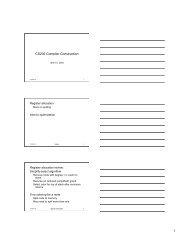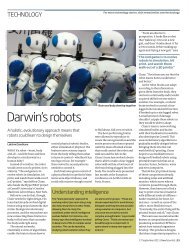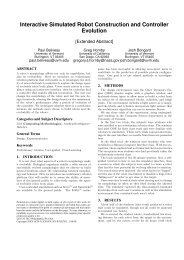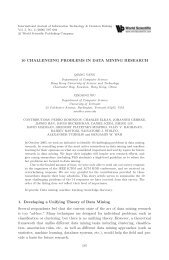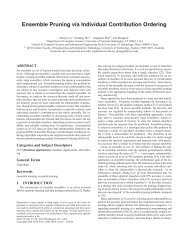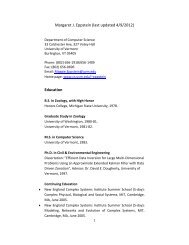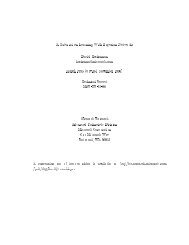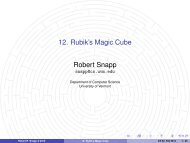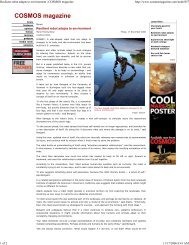Dictionaries and Tolerant Retrieval
Dictionaries and Tolerant Retrieval
Dictionaries and Tolerant Retrieval
Create successful ePaper yourself
Turn your PDF publications into a flip-book with our unique Google optimized e-Paper software.
Introduction to Information <strong>Retrieval</strong>Introduction toInformation <strong>Retrieval</strong>CS276: Information <strong>Retrieval</strong> <strong>and</strong> Web SearchChristopher Manning <strong>and</strong> Prabhakar RaghavanLecture 3: <strong>Dictionaries</strong> <strong>and</strong> tolerant retrieval1
Introduction to Information <strong>Retrieval</strong>Ch. 2Recap of the previous lecture• The type/token distinction• Terms are normalized types put in the dictionary• Tokenization problems:• Hyphens, apostrophes, compounds, Chinese• Term equivalence classing:• Numbers, case folding, stemming, lemmatization• Skip pointers• Encoding a tree‐like structure in a postings list• Biword indexes for phrases• Positional indexes for phrases/proximity queries2
Introduction to Information <strong>Retrieval</strong>Ch. 3This lecture• Dictionary data structures• “<strong>Tolerant</strong>” retrieval• Wild‐card queries• Spelling correction• Soundex3
Introduction to Information <strong>Retrieval</strong>Dictionary data structures for invertedindexesSec. 3.1• The dictionary data structure stores the termvocabulary, document frequency, pointers to eachpostings list … in what data structure?4
Introduction to Information <strong>Retrieval</strong>Sec. 3.1A naïve dictionary• An array of struct:char[20] int Postings *20 bytes 4/8 bytes 4/8 bytes• How do we store a dictionary in memory efficiently?• How do we quickly look up elements at query time?5
Introduction to Information <strong>Retrieval</strong>Sec. 3.1Dictionary dt data structurest• Two main choices:• Hash table• Tree• Some IR systems use hashes, some trees6
Introduction to Information <strong>Retrieval</strong>Sec. 3.1Hashes• Each vocabulary term is hashed to an integer• (We assume you’ve seen hashtables before)• Pros:• Lookup is faster than for a tree: O(1)• Cons:• No easy way to find minor variants:• judgment/judgement• No prefix search [tolerant retrieval]• If vocabulary keeps growing, need to occasionally do theexpensive operation of rehashing everything7
Introduction to Information <strong>Retrieval</strong>Sec. 3.1Tree: binary treea-mRootn-za-hu hy-m n-sh si-z8
Introduction to Information <strong>Retrieval</strong>Sec. 3.1Tree: B‐treea-huhy-mn-z• Definition: Every internal nodel has a number of childrenin the interval [a,b] where a, b are appropriate naturalnumbers, e.g., [2,4].9
Introduction to Information <strong>Retrieval</strong>Sec. 3.1Trees• Simplest: binary tree• More usual: B‐trees• Trees require a st<strong>and</strong>ard ordering of characters <strong>and</strong> hencestrings … but we st<strong>and</strong>ardly have one• Pros:• Solves the prefix problem (terms starting with hyp)• Cons:• Slower: O(log M) [<strong>and</strong> this requires balanced tree]• Rebalancing binary trees is expensive• But B‐trees mitigate the rebalancing problem10
Introduction to Information <strong>Retrieval</strong>Sec. 3.2Query processing• At this point, we have an enumeration of all terms inthe dictionary that match the wild‐card query.• We still have to look up the postings for eachenumerated term.• E.g., consider the query:se*ate AND fil*erThis may result in the execution of many BooleanAND queries.13
Introduction to Information <strong>Retrieval</strong>B‐trees h<strong>and</strong>le *’s at the end of aSec. 3.2query term• How can we h<strong>and</strong>le*’s in the middle of query term?• co*tion• We could look up co* AND *tion in a B‐tree <strong>and</strong>intersect the two term sets• Expensive• The solution: transform wild‐card queries so that the*’s occur at the end• This gives rise to the Permuterm Index.14
Introduction to Information <strong>Retrieval</strong>Sec. 3.2.1Permuterm index• For term hello, index under:• hello$, ello$h, llo$he, lo$hel, o$hellwhere $ is a special symbol.• Queries:• X lookup on X$ X* lookup on $X*• *X lookup on X$* *X* lookup on X*• X*Y lookup on Y$X* X*Y*Z ??? Exercise!Query = hel*oX=hel, Y=oLookup o$hel*15
Introduction to Information <strong>Retrieval</strong>Sec. 3.2.2Bigram (k‐gram) indexes• Enumerate all k‐grams (sequence of k chars)occurring in any term• e.g., g, from text “April p is the cruelest month” we getthe 2‐grams (bigrams)$a,ap,pr,ri,il,l$,$i,is,s$,$t,th,he,e$,$c,cr,ru,ap pr ri il l$ $i is s$ $t th he e$ $c cr ruue,el,le,es,st,t$, $m,mo,on,nt,h$• $ is a special word boundary symbol smbol• Maintain a second inverted index from bigrams todictionary terms that match each bigram.17
Introduction to Information <strong>Retrieval</strong>Sec. 3.2.2Bigram index example• The k‐gram index finds terms based on a queryconsisting of k‐grams (here k=2).$m macemaddenmoonamongamongamortizearound18
Introduction to Information <strong>Retrieval</strong>Sec. 3.2.2Processing wild‐cardsd• Query mon* can now be run as• $m AND mo AND on• Gets terms that match AND version of our wildcardquery.• But we’d enumerate moon.• Must post‐filter these terms against query.• Surviving enumerated e edterms sae are then looked upinthe term‐document inverted index.• Fast, space efficient (compared to permuterm).19
Introduction to Information <strong>Retrieval</strong>Sec. 3.2.2Processing wild‐card d queries• As before, we must execute a Boolean query for eachenumerated, filtered term.• Wild‐cards can result in expensive query execution(very large disjunctions…)• pyth* AND prog*• If you encourage “laziness” people will respond!Type your search terms, use ‘*’ if you need to.E.g., Alex* will match Alex<strong>and</strong>er.Search• Which web search engines allow wildcard queries? 20
Introduction to Information <strong>Retrieval</strong>SPELLING CORRECTION21
Introduction to Information <strong>Retrieval</strong>Sec. 3.3Spell correction• Two principal uses• Correcting document(s) being indexed• Correcting user queries to retrieve “right” answers• Two main flavors:• Isolated word• Check each word on its own for misspelling• Will not catch typos resulting in correctly spelled words• eg e.g., from → form• Context‐sensitive• Look at surrounding words,• e.g., I flew form Heathrow to Narita.22
Introduction to Information <strong>Retrieval</strong>Sec. 3.3Document correction• Especially needed for OCR’ed documents• Correction algorithms are tuned for this: rn/m• Can use domain‐specific knowledge• E.g., OCR can confuse O <strong>and</strong> D more often than it would confuse O<strong>and</strong> I (adjacent on the QWERTY keyboard, so more likelyinterchanged in typing).• But also: web pages <strong>and</strong> even printed material hastypos• Goal: the dictionary contains fewer misspellings• But often we don’t change the documents but aim tofix the query‐document mapping23
Introduction to Information <strong>Retrieval</strong>Sec. 3.3Query mis‐spellings• Our principal focus here• E.g., the query Alanis Morisett• We can either• Retrieve documents indexed by the correct spelling, OR• Return several suggested alternative queries with thecorrect spelling• Did you mean … ?24
Introduction to Information <strong>Retrieval</strong>Sec. 3.3.2Isolated word correction• Fundamental premise– there is a lexicon from whichthe correct spellings come• Two basic choices for this• A st<strong>and</strong>ard lexicon such as• Webster’s English Dictionary• An “industry‐specific” lexicon – h<strong>and</strong>‐maintained• The lexicon of the indexed corpus• E.g., all words on the web• All names, acronyms etc.• (Including the mis‐spellings)25
Introduction to Information <strong>Retrieval</strong>Sec. 3.3.2Isolated word correction• Given a lexicon <strong>and</strong> a character sequence Q, returnthe words in the lexicon closest to Q• What’s “closest”?• We’ll study several alternatives• Edit distance (Levenshtein distance)• Weighted edit distance• n‐gram overlap26
Introduction to Information <strong>Retrieval</strong>Sec. 3.3.3Edit distance• Given two strings S 1 <strong>and</strong> S 2 , the minimum number ofoperations to convert one to the other• Operations are typically y character‐level• Insert, Delete, Replace, (Transposition)• E.g., g, the edit distance from dof to dog is 1• From cat to act is 2• from cat to dog is 3.(Just 1 with transpose.)• Generally found by dynamic programming.• See http://www.merriampark.com/ld.htm for a niceexample plus an applet.27
Introduction to Information <strong>Retrieval</strong>Sec. 3.3.3Wihtd Weighted edit distance• As above, but the weight of an operation depends onthe character(s) involved• Meant to capture OCR or keyboard errors, e.g. m morelikely to be mis‐typed as n than as q• Therefore, replacing m by n is a smaller edit distance thanby q• This may be formulated as a probability model• Requires weight matrix as input• Modify dynamic programming to h<strong>and</strong>le weights28
Introduction to Information <strong>Retrieval</strong>Sec. 3.3.4Ui Using edit distances• Given query, first enumerate all character sequenceswithin a preset (weighted) edit distance (e.g., 2)• Intersect this set with list of “correct” words• Show terms you found to user as suggestions• Alternatively,• We can look up all possible corrections in our invertedindex <strong>and</strong> return all docs … slow• We can run with a single most likely correction• The alternatives disempower the user, but save around of interaction with the user29
Introduction to Information <strong>Retrieval</strong>Sec. 3.3.4Edit distance to all dictionary i terms?• Given a (mis‐spelled) spelled) query – do we compute its editdistance to every dictionary term?• Expensive <strong>and</strong> slow• Alternative?• How do we cut the set of c<strong>and</strong>idate dictionaryterms?• One possibility is to use n‐gram overlap for this• This can also be used by itself for spelling correction.30
Introduction to Information <strong>Retrieval</strong>Sec. 3.3.4n‐gram overlap• Enumerate all the n‐grams in the query string as wellas in the lexicon• Use the n‐gram g index (recall wild‐card search) toretrieve all lexicon terms matching any of the queryn‐grams• Threshold by number of matching n‐grams• Variants –weight by keyboard layout, etc.31
Introduction to Information <strong>Retrieval</strong>Sec. 3.3.4Example with ti trigrams• Suppose the text is november• Trigrams are nov, ove, vem, emb, mbe, ber.• The query is december• Trigrams are dec, ece, cem, emb, mbe, ber.• So 3 trigrams overlap (of 6 in each term)• How can we turn this into a normalized measure ofoverlap?32
Introduction to Information <strong>Retrieval</strong>Sec. 3.3.4One option – Jaccard coefficienti • A commonly‐used measure of overlap• Let X <strong>and</strong> Y be two sets; then the J.C. isX∩ Y /X∪Y• Equals 1 when X <strong>and</strong> Y have the same elements <strong>and</strong>zero when they are disjoint• X <strong>and</strong> Y don’t have to be of the same size• Always assigns a number between 0 <strong>and</strong> 1• Now threshold to decide if you have a match• E.g., if J.C. > 0.8, declare a match33
Introduction to Information <strong>Retrieval</strong>Sec. 3.3.4Mthi Matching trigrams ti• Consider the query lord – we wish to identify wordsmatching 2 of its 3 bigrams (lo, or, rd)lo alone lord slothor border lord morbidrd ardent border cardSt<strong>and</strong>ard postings “merge” will enumerate …Adapt this to using Jaccard (or another) measure.34
Introduction to Information <strong>Retrieval</strong>Sec. 3.3.5Context‐sensitive t spell correction• Text: I flew from Heathrow to Narita.• Consider the phrase query “flew form Heathrow”• We’d like to respondDid you mean “flew from Heathrow”?because no docs matched the query phrase.35
Introduction to Information <strong>Retrieval</strong>Sec. 3.3.5Context‐sensitive t correction• Need surrounding context to catch this.• First idea: retrieve dictionary terms close (inweighted edit distance) to each query term• Now try all possible resulting phrases with one word“fixed” at a time• flew from heathrow• fled form heathrow• flea form heathrow• Hit‐based spelling correction: Suggest thealternative that has lots of hits.36
Introduction to Information <strong>Retrieval</strong>Sec. 3.3.5Exercise• Suppose that for “flew form Heathrow” we have 7alternatives for flew, 19 for form <strong>and</strong> 3 for heathrow.How many “corrected” phrases will we enumerate inthis scheme?37
Introduction to Information <strong>Retrieval</strong>Sec. 3.3.5Another approach• Break phrase query into a conjunction of biwords(Lecture 2).• Look for biwords that need only one term corrected.• Enumerate phrase matches <strong>and</strong> … rank them!38
Introduction to Information <strong>Retrieval</strong>Sec. 3.3.5General lissues in spell correction• We enumerate multiple alternatives for “Did youmean?”• Need to figure out which to present to the user• Use heuristics• The alternative hitting most docs• Query log analysis + tweaking• For especially popular, topical queries• Spell‐correction is computationally expensive• Avoid running routinely on every query?• Run only on queries that matched hdfew docs39
Introduction to Information <strong>Retrieval</strong>SOUNDEX40
Introduction to Information <strong>Retrieval</strong>Sec. 3.4Soundex• Class of heuristics to exp<strong>and</strong> a query into phoneticequivalents• Language specific – mainly for names• E.g., chebyshev → tchebycheff• Invented for the U.S. census … in 191841
Introduction to Information <strong>Retrieval</strong>Sec. 3.4Soundex – typical algorithm• Turn every token to be indexed into a 4‐characterreduced form• Do the same with query terms• Build <strong>and</strong> search an index on the reduced forms• (when the query calls for a soundex match)• http://www.creativyst.com/Doc/Articles/SoundEx1/SoundEx1.htm#Top42
Introduction to Information <strong>Retrieval</strong>Sec. 3.4Soundex – typical algorithm1. Retain the first letter of the word.2. Change all occurrences of the following letters to '0'(zero):'A',' E', '' 'I', 'O',' 'U',' 'H',' 'W',' '' 'Y'.3. Change letters to digits as follows:• B, F, P, V → 1• C, G, J, K, Q, S, X, Z → 2• DT→ D,T → 3• L → 4• M, N → 5• R → 643
Introduction to Information <strong>Retrieval</strong>Sec. 3.4Soundex continued4. Remove all pairs of consecutive digits.5. Remove all zeros from the resulting string.6. Pad the resulting string with trailing zeros <strong>and</strong>return the first four positions, which will be of theform .E.g., g, Herman becomes H655.Will hermann generate the same code?44
Introduction to Information <strong>Retrieval</strong>Sec. 3.4Soundex• Soundex is the classic algorithm, provided by mostdatabases (Oracle, Microsoft, …)• How useful is soundex?• Not very –for information retrieval• Okay for “high recall” tasks (e.g., Interpol), thoughbiased to names of certain nationalities• Zobel <strong>and</strong> Dart (1996) show that other algorithms forphonetic matching perform much better in thecontext of IR45
Introduction to Information <strong>Retrieval</strong>What queries can we process?• We have• Positional inverted index with skip pointers• Wild‐card index• Spell‐correction• Soundex• Queries such as(SPELL(moriset) /3 toron*to) OR SOUNDEX(chaikofski)46
Introduction to Information <strong>Retrieval</strong>Exercise• Draw yourself a diagram showing the various indexesin a search engine incorporating all the functionalitywe have talked about• Identify some of the key design choices in the indexpipeline:• Does stemming happen before the Soundex index?• What about n‐grams?• Given a query, how would you parse <strong>and</strong> dispatchsub‐queries to the various indexes?47
Introduction to Information <strong>Retrieval</strong>Sec. 3.5Resources• IIR 3, MG 4.2• Efficient spell retrieval:• K. Kukich. Techniques for automatically correcting words in text. ACMComputing Surveys 24(4), Dec 1992.• J. Zobel <strong>and</strong> P. Dart. Finding approximate matches in largelexicons. Software ‐ practice <strong>and</strong> experience 25(3), March 1995.http://citeseer.ist.psu.edu/zobel95finding.html• Mikael Tillenius: Efficient Generation <strong>and</strong> Ranking of Spelling ErrorCorrections. Master’s thesis at Sweden’s Royal Institute of Technology.http://citeseer.ist.psu.edu/179155.html• Nice, easy reading on spell correction:• Peter Norvig: How to write a spelling correctorh http://norvig.com/spell‐correct.html/ h l48



